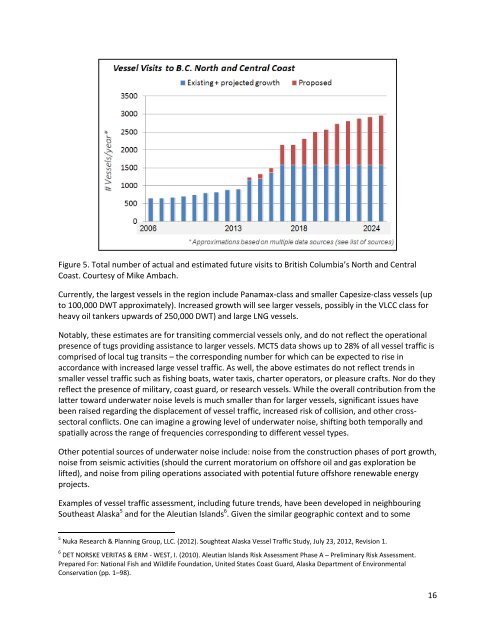mcbem-2014-01-submission-wwf-en
mcbem-2014-01-submission-wwf-en
mcbem-2014-01-submission-wwf-en
You also want an ePaper? Increase the reach of your titles
YUMPU automatically turns print PDFs into web optimized ePapers that Google loves.
Figure 5. Total number of actual and estimated future visits to British Columbia’s North and C<strong>en</strong>tral<br />
Coast. Courtesy of Mike Ambach.<br />
Curr<strong>en</strong>tly, the largest vessels in the region include Panamax-class and smaller Capesize-class vessels (up<br />
to 100,000 DWT approximately). Increased growth will see larger vessels, possibly in the VLCC class for<br />
heavy oil tankers upwards of 250,000 DWT) and large LNG vessels.<br />
Notably, these estimates are for transiting commercial vessels only, and do not reflect the operational<br />
pres<strong>en</strong>ce of tugs providing assistance to larger vessels. MCTS data shows up to 28% of all vessel traffic is<br />
comprised of local tug transits – the corresponding number for which can be expected to rise in<br />
accordance with increased large vessel traffic. As well, the above estimates do not reflect tr<strong>en</strong>ds in<br />
smaller vessel traffic such as fishing boats, water taxis, charter operators, or pleasure crafts. Nor do they<br />
reflect the pres<strong>en</strong>ce of military, coast guard, or research vessels. While the overall contribution from the<br />
latter toward underwater noise levels is much smaller than for larger vessels, significant issues have<br />
be<strong>en</strong> raised regarding the displacem<strong>en</strong>t of vessel traffic, increased risk of collision, and other crosssectoral<br />
conflicts. One can imagine a growing level of underwater noise, shifting both temporally and<br />
spatially across the range of frequ<strong>en</strong>cies corresponding to differ<strong>en</strong>t vessel types.<br />
Other pot<strong>en</strong>tial sources of underwater noise include: noise from the construction phases of port growth,<br />
noise from seismic activities (should the curr<strong>en</strong>t moratorium on offshore oil and gas exploration be<br />
lifted), and noise from piling operations associated with pot<strong>en</strong>tial future offshore r<strong>en</strong>ewable <strong>en</strong>ergy<br />
projects.<br />
Examples of vessel traffic assessm<strong>en</strong>t, including future tr<strong>en</strong>ds, have be<strong>en</strong> developed in neighbouring<br />
Southeast Alaska 5 and for the Aleutian Islands 6 . Giv<strong>en</strong> the similar geographic context and to some<br />
5 Nuka Research & Planning Group, LLC. (2<strong>01</strong>2). Soughteat Alaska Vessel Traffic Study, July 23, 2<strong>01</strong>2, Revision 1.<br />
6 DET NORSKE VERITAS & ERM - WEST, I. (2<strong>01</strong>0). Aleutian Islands Risk Assessm<strong>en</strong>t Phase A – Preliminary Risk Assessm<strong>en</strong>t.<br />
Prepared For: National Fish and Wildlife Foundation, United States Coast Guard, Alaska Departm<strong>en</strong>t of Environm<strong>en</strong>tal<br />
Conservation (pp. 1–98).<br />
16


